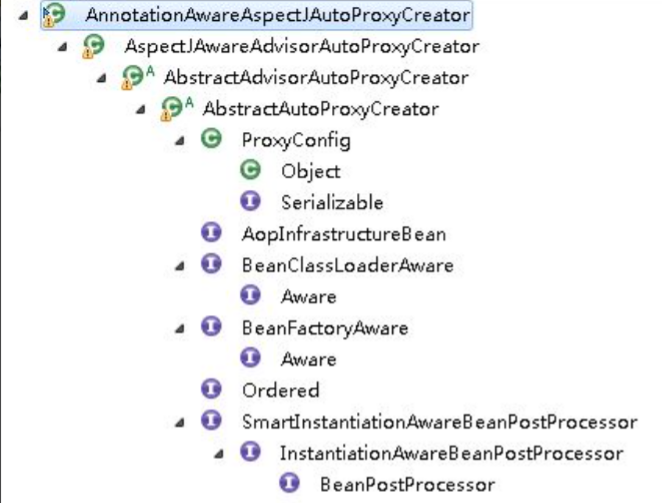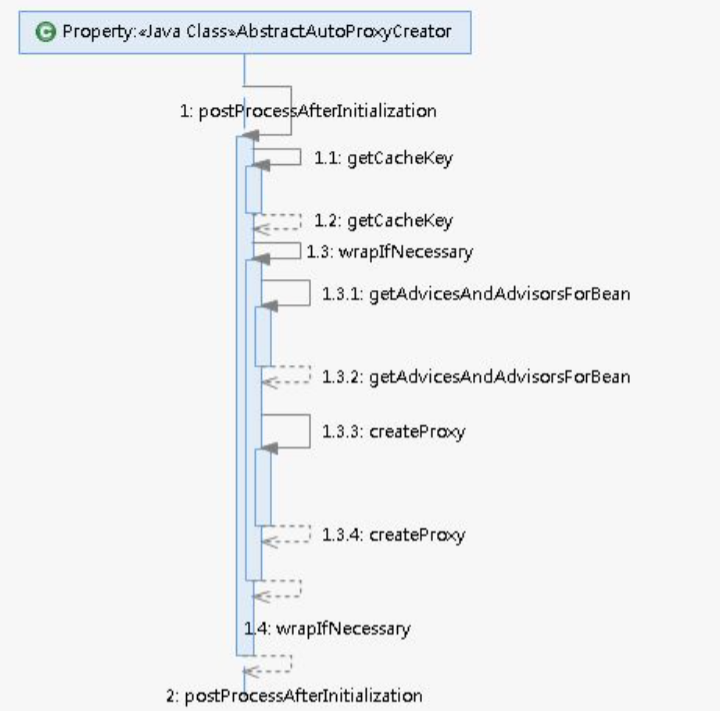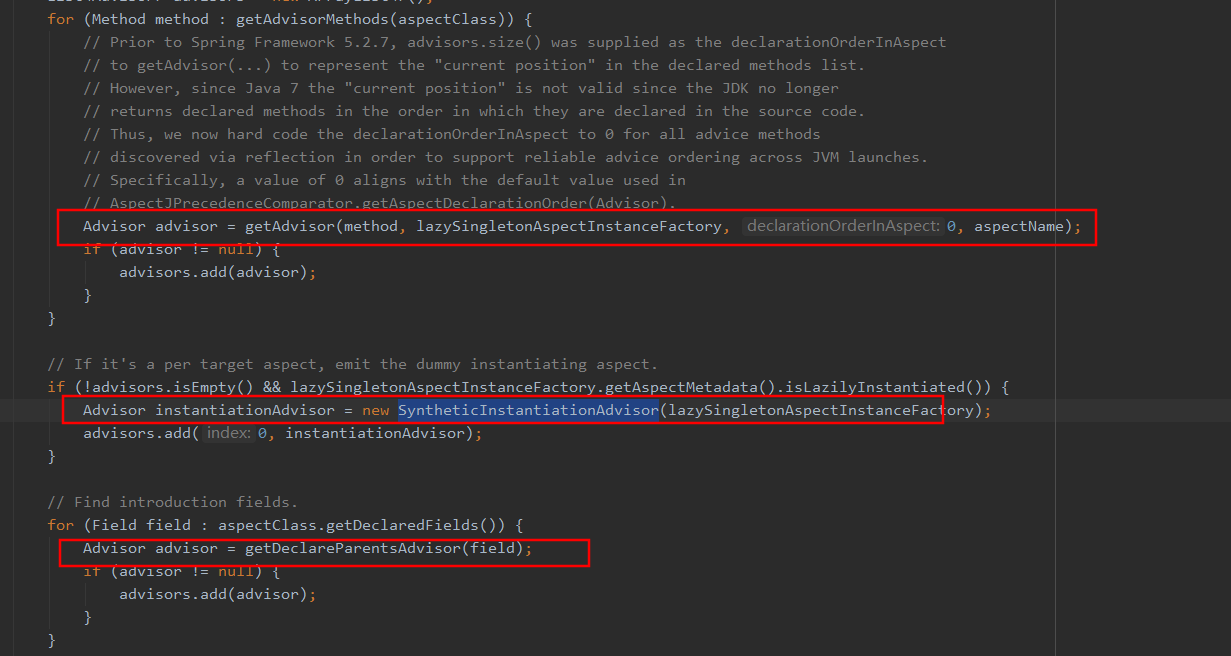Spring可以以注解的方式使用AOP的原因就是在XML中<aop:aspectj-autoproxy/>,分析注解式AOP就要从这句话入手
动态AOP自定义标签
一旦遇到<aop:aspectj-autoproxy/>在AopNamespaceHandler就会注册AspectJAutoProxyBeanDefinitionParser
注册AnnotationAwareAspectJAutoProxyCreator
在AspectJAutoProxyBeanDefinitionParser的parse中注册了AnnotationAwareAspectJAutoProxyCreator
public static void registerAspectJAnnotationAutoProxyCreatorIfNecessary(ParserContext parserContext, Element sourceElement) {BeanDefinition beanDefinition = AopConfigUtils.registerAspectJAnnotationAutoProxyCreatorIfNecessary(parserContext.getRegistry(), parserContext.extractSource(sourceElement));useClassProxyingIfNecessary(parserContext.getRegistry(), sourceElement);registerComponentIfNecessary(beanDefinition, parserContext);}
注册或者升级
AnnotationAwareAspectJAutoProxyCreator@Nullableprivate static BeanDefinition registerOrEscalateApcAsRequired(Class<?> cls, BeanDefinitionRegistry registry, @Nullable Object source) {Assert.notNull(registry, "BeanDefinitionRegistry must not be null");if (registry.containsBeanDefinition(AUTO_PROXY_CREATOR_BEAN_NAME)) {BeanDefinition apcDefinition = registry.getBeanDefinition(AUTO_PROXY_CREATOR_BEAN_NAME);if (!cls.getName().equals(apcDefinition.getBeanClassName())) {int currentPriority = findPriorityForClass(apcDefinition.getBeanClassName());int requiredPriority = findPriorityForClass(cls);if (currentPriority < requiredPriority) {apcDefinition.setBeanClassName(cls.getName());}}return null;}RootBeanDefinition beanDefinition = new RootBeanDefinition(cls);beanDefinition.setSource(source);beanDefinition.getPropertyValues().add("order", Ordered.HIGHEST_PRECEDENCE);beanDefinition.setRole(BeanDefinition.ROLE_INFRASTRUCTURE);registry.registerBeanDefinition(AUTO_PROXY_CREATOR_BEAN_NAME, beanDefinition);return beanDefinition;}
实现了自动注册
AnnotationAwareAspectJAutoProxyCreator类的功能处理proxy-target-class以及expose-proxy属性
private static void useClassProxyingIfNecessary(BeanDefinitionRegistry registry, @Nullable Element sourceElement) {if (sourceElement != null) {boolean proxyTargetClass = Boolean.parseBoolean(sourceElement.getAttribute(PROXY_TARGET_CLASS_ATTRIBUTE));if (proxyTargetClass) {AopConfigUtils.forceAutoProxyCreatorToUseClassProxying(registry);}boolean exposeProxy = Boolean.parseBoolean(sourceElement.getAttribute(EXPOSE_PROXY_ATTRIBUTE));if (exposeProxy) {AopConfigUtils.forceAutoProxyCreatorToExposeProxy(registry);}}}
proxy-target-class:设置为true,强制使用CGLIB- 无法通知
final - 需要引入cglib包
- CGLIB底层依靠ASM
- 无法通知
expose-proxy:暴露代理对象,解决同类调用问题((AService)AopContext.currentProxy()).b();
创建AOP代理
AnnotationAwareAspectJAutoProxyCreator是用来创建AOP代理对象的,类结构如下:
类是实现了BeanPostProcessor的,主要是其postProcessAfterInitialization中的逻辑
@Overridepublic Object postProcessAfterInitialization(@Nullable Object bean, String beanName) {if (bean != null) {Object cacheKey = getCacheKey(bean.getClass(), beanName);if (this.earlyProxyReferences.remove(cacheKey) != bean) {return wrapIfNecessary(bean, beanName, cacheKey);}}return bean;}protected Object wrapIfNecessary(Object bean, String beanName, Object cacheKey) {if (StringUtils.hasLength(beanName) && this.targetSourcedBeans.contains(beanName)) {return bean;}if (Boolean.FALSE.equals(this.advisedBeans.get(cacheKey))) {return bean;}if (isInfrastructureClass(bean.getClass()) || shouldSkip(bean.getClass(), beanName)) {this.advisedBeans.put(cacheKey, Boolean.FALSE);return bean;}// Create proxy if we have advice.Object[] specificInterceptors = getAdvicesAndAdvisorsForBean(bean.getClass(), beanName, null);if (specificInterceptors != DO_NOT_PROXY) {this.advisedBeans.put(cacheKey, Boolean.TRUE);Object proxy = createProxy(bean.getClass(), beanName, specificInterceptors, new SingletonTargetSource(bean));this.proxyTypes.put(cacheKey, proxy.getClass());return proxy;}this.advisedBeans.put(cacheKey, Boolean.FALSE);return bean;}
- 获取增强方法或者增强器
- 根据获取的增强器惊醒代理

@Override@Nullableprotected Object[] getAdvicesAndAdvisorsForBean(Class<?> beanClass, String beanName, @Nullable TargetSource targetSource) {List<Advisor> advisors = findEligibleAdvisors(beanClass, beanName);if (advisors.isEmpty()) {return DO_NOT_PROXY;}return advisors.toArray();}protected List<Advisor> findEligibleAdvisors(Class<?> beanClass, String beanName) {List<Advisor> candidateAdvisors = findCandidateAdvisors();List<Advisor> eligibleAdvisors = findAdvisorsThatCanApply(candidateAdvisors, beanClass, beanName);extendAdvisors(eligibleAdvisors);if (!eligibleAdvisors.isEmpty()) {eligibleAdvisors = sortAdvisors(eligibleAdvisors);}return eligibleAdvisors;}
主要做了两件事: findCandidateAdvisors findAdvisorsThatCanApply
获取增强器-findCandidateAdvisors
@Overrideprotected List<Advisor> findCandidateAdvisors() {// Add all the Spring advisors found according to superclass rules.List<Advisor> advisors = super.findCandidateAdvisors();// Build Advisors for all AspectJ aspects in the bean factory.if (this.aspectJAdvisorsBuilder != null) {advisors.addAll(this.aspectJAdvisorsBuilder.buildAspectJAdvisors());}return advisors;}@Overrideprotected List<Advisor> findCandidateAdvisors() {// Add all the Spring advisors found according to superclass rules.List<Advisor> advisors = super.findCandidateAdvisors();// Build Advisors for all AspectJ aspects in the bean factory.if (this.aspectJAdvisorsBuilder != null) {advisors.addAll(this.aspectJAdvisorsBuilder.buildAspectJAdvisors());}return advisors;}
this.aspectJAdvisorsBuilder.buildAspectJAdvisors()才是获取注解增强功能的
public List<Advisor> buildAspectJAdvisors() {List<String> aspectNames = this.aspectBeanNames;if (aspectNames == null) {synchronized (this) {aspectNames = this.aspectBeanNames;if (aspectNames == null) {List<Advisor> advisors = new ArrayList<>();aspectNames = new ArrayList<>();String[] beanNames = BeanFactoryUtils.beanNamesForTypeIncludingAncestors(this.beanFactory, Object.class, true, false);for (String beanName : beanNames) {if (!isEligibleBean(beanName)) {continue;}// We must be careful not to instantiate beans eagerly as in this case they// would be cached by the Spring container but would not have been weaved.Class<?> beanType = this.beanFactory.getType(beanName, false);if (beanType == null) {continue;}if (this.advisorFactory.isAspect(beanType)) {aspectNames.add(beanName);AspectMetadata amd = new AspectMetadata(beanType, beanName);if (amd.getAjType().getPerClause().getKind() == PerClauseKind.SINGLETON) {MetadataAwareAspectInstanceFactory factory =new BeanFactoryAspectInstanceFactory(this.beanFactory, beanName);List<Advisor> classAdvisors = this.advisorFactory.getAdvisors(factory);if (this.beanFactory.isSingleton(beanName)) {this.advisorsCache.put(beanName, classAdvisors);}else {this.aspectFactoryCache.put(beanName, factory);}advisors.addAll(classAdvisors);}else {// Per target or per this.if (this.beanFactory.isSingleton(beanName)) {throw new IllegalArgumentException("Bean with name '" + beanName +"' is a singleton, but aspect instantiation model is not singleton");}MetadataAwareAspectInstanceFactory factory =new PrototypeAspectInstanceFactory(this.beanFactory, beanName);this.aspectFactoryCache.put(beanName, factory);advisors.addAll(this.advisorFactory.getAdvisors(factory));}}}this.aspectBeanNames = aspectNames;return advisors;}}}if (aspectNames.isEmpty()) {return Collections.emptyList();}List<Advisor> advisors = new ArrayList<>();for (String aspectName : aspectNames) {List<Advisor> cachedAdvisors = this.advisorsCache.get(aspectName);if (cachedAdvisors != null) {advisors.addAll(cachedAdvisors);}else {MetadataAwareAspectInstanceFactory factory = this.aspectFactoryCache.get(aspectName);advisors.addAll(this.advisorFactory.getAdvisors(factory));}}return advisors;}//上面代码的关键@Overridepublic List<Advisor> getAdvisors(MetadataAwareAspectInstanceFactory aspectInstanceFactory) {Class<?> aspectClass = aspectInstanceFactory.getAspectMetadata().getAspectClass();String aspectName = aspectInstanceFactory.getAspectMetadata().getAspectName();validate(aspectClass);// We need to wrap the MetadataAwareAspectInstanceFactory with a decorator// so that it will only instantiate once.MetadataAwareAspectInstanceFactory lazySingletonAspectInstanceFactory =new LazySingletonAspectInstanceFactoryDecorator(aspectInstanceFactory);List<Advisor> advisors = new ArrayList<>();for (Method method : getAdvisorMethods(aspectClass)) {// Prior to Spring Framework 5.2.7, advisors.size() was supplied as the declarationOrderInAspect// to getAdvisor(...) to represent the "current position" in the declared methods list.// However, since Java 7 the "current position" is not valid since the JDK no longer// returns declared methods in the order in which they are declared in the source code.// Thus, we now hard code the declarationOrderInAspect to 0 for all advice methods// discovered via reflection in order to support reliable advice ordering across JVM launches.// Specifically, a value of 0 aligns with the default value used in// AspectJPrecedenceComparator.getAspectDeclarationOrder(Advisor).Advisor advisor = getAdvisor(method, lazySingletonAspectInstanceFactory, 0, aspectName);if (advisor != null) {advisors.add(advisor);}}// If it's a per target aspect, emit the dummy instantiating aspect.if (!advisors.isEmpty() && lazySingletonAspectInstanceFactory.getAspectMetadata().isLazilyInstantiated()) {Advisor instantiationAdvisor = new SyntheticInstantiationAdvisor(lazySingletonAspectInstanceFactory);advisors.add(0, instantiationAdvisor);}// Find introduction fields.for (Field field : aspectClass.getDeclaredFields()) {Advisor advisor = getDeclareParentsAdvisor(field);if (advisor != null) {advisors.add(advisor);}}return advisors;}

普通增强器的获取
@Override@Nullablepublic Advisor getAdvisor(Method candidateAdviceMethod, MetadataAwareAspectInstanceFactory aspectInstanceFactory,int declarationOrderInAspect, String aspectName) {validate(aspectInstanceFactory.getAspectMetadata().getAspectClass());//切点获取AspectJExpressionPointcut expressionPointcut = getPointcut(candidateAdviceMethod, aspectInstanceFactory.getAspectMetadata().getAspectClass());if (expressionPointcut == null) {return null;}//根据切点信息生成增强return new InstantiationModelAwarePointcutAdvisorImpl(expressionPointcut, candidateAdviceMethod,this, aspectInstanceFactory, declarationOrderInAspect, aspectName);}
增加同步实例化增强器
-
寻找匹配增强器-findAdvisorsThatCanApply
从所有增强器中寻找这个Bean可以用的上的
protected List<Advisor> findAdvisorsThatCanApply(List<Advisor> candidateAdvisors, Class<?> beanClass, String beanName) {ProxyCreationContext.setCurrentProxiedBeanName(beanName);try {return AopUtils.findAdvisorsThatCanApply(candidateAdvisors, beanClass);}finally {ProxyCreationContext.setCurrentProxiedBeanName(null);}}
AopUtils#findAdvisorsThatCanApply
-
创建代理
protected Object createProxy(Class<?> beanClass, @Nullable String beanName,@Nullable Object[] specificInterceptors, TargetSource targetSource) {if (this.beanFactory instanceof ConfigurableListableBeanFactory) {AutoProxyUtils.exposeTargetClass((ConfigurableListableBeanFactory) this.beanFactory, beanName, beanClass);}ProxyFactory proxyFactory = new ProxyFactory();proxyFactory.copyFrom(this);if (!proxyFactory.isProxyTargetClass()) {if (shouldProxyTargetClass(beanClass, beanName)) {proxyFactory.setProxyTargetClass(true);}else {evaluateProxyInterfaces(beanClass, proxyFactory);}}Advisor[] advisors = buildAdvisors(beanName, specificInterceptors);proxyFactory.addAdvisors(advisors);proxyFactory.setTargetSource(targetSource);customizeProxyFactory(proxyFactory);proxyFactory.setFrozen(this.freezeProxy);if (advisorsPreFiltered()) {proxyFactory.setPreFiltered(true);}// Use original ClassLoader if bean class not locally loaded in overriding class loaderClassLoader classLoader = getProxyClassLoader();if (classLoader instanceof SmartClassLoader && classLoader != beanClass.getClassLoader()) {classLoader = ((SmartClassLoader) classLoader).getOriginalClassLoader();}return proxyFactory.getProxy(classLoader);}
Spring委托给
ProxyFactory去处理 获取当前类中的属性
- 添加代理接口
- 封装
Advisor并加入ProxyFactory - 设置要代理的类
- Spring提供子类可拓展的方法
customizeProxyFactory - 进行获取代理操作
创建代理
```java protected final synchronized AopProxy createAopProxy() {
}if (!this.active) {activate();}return getAopProxyFactory().createAopProxy(this);
@Overridepublic AopProxy createAopProxy(AdvisedSupport config) throws AopConfigException {if (!NativeDetector.inNativeImage() &&(config.isOptimize() || config.isProxyTargetClass() || hasNoUserSuppliedProxyInterfaces(config))) {Class<?> targetClass = config.getTargetClass();if (targetClass == null) {throw new AopConfigException("TargetSource cannot determine target class: " +"Either an interface or a target is required for proxy creation.");}if (targetClass.isInterface() || Proxy.isProxyClass(targetClass)) {return new JdkDynamicAopProxy(config);}return new ObjenesisCglibAopProxy(config);}else {return new JdkDynamicAopProxy(config);}}
1. `optimize`:用来控制通过CGLIB创建的代理是否使用激进优化,仅用于CGLIB2. `proxyTargetClass`:为true时CGLIB被使用<a name="A7alH"></a>### 获取代理1. Spring中应用JDK动态代理`org.springframework.aop.framework.JdkDynamicAopProxy#getProxy(java.lang.ClassLoader)````java@Overridepublic Object getProxy(@Nullable ClassLoader classLoader) {if (logger.isTraceEnabled()) {logger.trace("Creating JDK dynamic proxy: " + this.advised.getTargetSource());}return Proxy.newProxyInstance(classLoader, this.proxiedInterfaces, this);}
JdkDynamicAopProxy的invoke函数
@Override@Nullablepublic Object invoke(Object proxy, Method method, Object[] args) throws Throwable {Object oldProxy = null;boolean setProxyContext = false;TargetSource targetSource = this.advised.targetSource;Object target = null;try {if (!this.equalsDefined && AopUtils.isEqualsMethod(method)) {// The target does not implement the equals(Object) method itself.return equals(args[0]);}else if (!this.hashCodeDefined && AopUtils.isHashCodeMethod(method)) {// The target does not implement the hashCode() method itself.return hashCode();}else if (method.getDeclaringClass() == DecoratingProxy.class) {// There is only getDecoratedClass() declared -> dispatch to proxy config.return AopProxyUtils.ultimateTargetClass(this.advised);}else if (!this.advised.opaque && method.getDeclaringClass().isInterface() &&method.getDeclaringClass().isAssignableFrom(Advised.class)) {// Service invocations on ProxyConfig with the proxy config...return AopUtils.invokeJoinpointUsingReflection(this.advised, method, args);}Object retVal;if (this.advised.exposeProxy) {// Make invocation available if necessary.oldProxy = AopContext.setCurrentProxy(proxy);setProxyContext = true;}// Get as late as possible to minimize the time we "own" the target,// in case it comes from a pool.target = targetSource.getTarget();Class<?> targetClass = (target != null ? target.getClass() : null);// Get the interception chain for this method.List<Object> chain = this.advised.getInterceptorsAndDynamicInterceptionAdvice(method, targetClass);// Check whether we have any advice. If we don't, we can fallback on direct// reflective invocation of the target, and avoid creating a MethodInvocation.if (chain.isEmpty()) {// We can skip creating a MethodInvocation: just invoke the target directly// Note that the final invoker must be an InvokerInterceptor so we know it does// nothing but a reflective operation on the target, and no hot swapping or fancy proxying.Object[] argsToUse = AopProxyUtils.adaptArgumentsIfNecessary(method, args);retVal = AopUtils.invokeJoinpointUsingReflection(target, method, argsToUse);}else {// We need to create a method invocation...MethodInvocation invocation =new ReflectiveMethodInvocation(proxy, target, method, args, targetClass, chain);// Proceed to the joinpoint through the interceptor chain.retVal = invocation.proceed();}// Massage return value if necessary.Class<?> returnType = method.getReturnType();if (retVal != null && retVal == target &&returnType != Object.class && returnType.isInstance(proxy) &&!RawTargetAccess.class.isAssignableFrom(method.getDeclaringClass())) {// Special case: it returned "this" and the return type of the method// is type-compatible. Note that we can't help if the target sets// a reference to itself in another returned object.retVal = proxy;}else if (retVal == null && returnType != Void.TYPE && returnType.isPrimitive()) {throw new AopInvocationException("Null return value from advice does not match primitive return type for: " + method);}return retVal;}finally {if (target != null && !targetSource.isStatic()) {// Must have come from TargetSource.targetSource.releaseTarget(target);}if (setProxyContext) {// Restore old proxy.AopContext.setCurrentProxy(oldProxy);}}}
最主要的工作就是创建了一个拦截器链,并使用ReflectiveMethodInvocation类进行了链的封装,而在ReflectiveMethodInvocation类的proceed方法中实现了拦截器的逐一调用
- CGLIB方式

